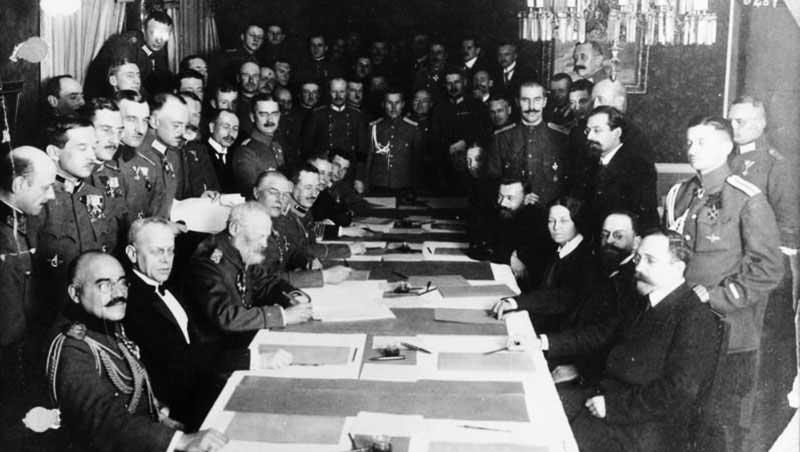3 March 1918
Signing an extremely disadvantageous peace treaty with Germany was the only option for the Bolsheviks to maintain power after the October Revolution. Lenin took it as a temporary tactical maneuver.

Talks Of Armistice Between Russia And Germany. Unknown Photographer (15. December 1917)
Background
When Bolsheviks seized power in October 1917, their first concern was to exit the war at any cost. Their popularity was based on a slogan “Peace! Bread! Land!”. The ceasefire with Germany was agreed in December 1917.
Peace Talks
The two delegations met at Brest-Litovsk (today’s Brest in Belarus) in December 1917. There was Richard von Kühlmann from Germany, Ottokar Czernin from Austria-Hungary and Talat Pasha from the Ottoman Empire. Soviet delegation was lead by Trotsky, Joffe and Kamenev.
Trotsky declared they wanted “Peace without annexations or indemnities”. Germans had already occupied a quarter of Russia’s territory so they did not agree. Trotsky thereafter relied on dilatory tactics and left the talks declaring unilateral end to hostilities.
Germans then occupied the Baltic States and half of Ukraine. Lenin finally agreed to Germany’s terms on 3 March 1918.
Treaty of Brest-Litovsk
Russia gave up 500,000 km² of land. It was a quarter of the whole population and a quarter of states’s industry including 90% of its coal mines. Russians declared the treaty void immediately after Germany had surrendered 11 November 1918.
Treaty of Brest-Litovsk
3 March 1918
Signing an extremely disadvantageous peace treaty with Germany was the only option for the Bolsheviks to maintain power after the October Revolution. Lenin took it as a temporary tactical maneuver.
Talks Of Armistice Between Russia And Germany. Unknown Photographer (15. December 1917)
Background
When Bolsheviks seized power in October 1917, their first concern was to exit the war at any cost. Their popularity was based on a slogan “Peace! Bread! Land!”. The ceasefire with Germany was agreed in December 1917.
Peace Talks
The two delegations met at Brest-Litovsk (today’s Brest in Belarus) in December 1917. There was Richard von Kühlmann from Germany, Ottokar Czernin from Austria-Hungary and Talat Pasha from the Ottoman Empire. Soviet delegation was lead by Trotsky, Joffe and Kamenev.
Trotsky declared they wanted “Peace without annexations or indemnities”. Germans had already occupied a quarter of Russia’s territory so they did not agree. Trotsky thereafter relied on dilatory tactics and left the talks declaring unilateral end to hostilities.
Germans then occupied the Baltic States and half of Ukraine. Lenin finally agreed to Germany’s terms on 3 March 1918.
Treaty of Brest-Litovsk
Russia gave up 500,000 km² of land. It was a quarter of the whole population and a quarter of states’s industry including 90% of its coal mines. Russians declared the treaty void immediately after Germany had surrendered 11 November 1918.
Alexander Kolchak